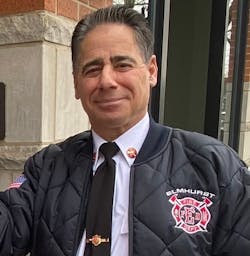10 Steps to Reimagining Your Fire Department in 2024
The term reimagining has been popularized recently by people who want to do things better or differently within themselves or an organization. Reimagining is about recreating, doing things in a new and creative way, changing a culture or even reworking a current process.
Imagine a fire service in which fire departments are defined by their capability to inspire, foster collaboration, and create experiences for their firefighters and the citizens who they serve that are simple, meaningful and enjoyable. Does it sound like some impossible or distant dimension? It really isn’t. We must leverage these challenging and uncertain times to reinvent and reshape how we operate today.
Three questions
The fire service in the United States has operated in essentially the same manner for hundreds of years. Our mission—to save lives and property—has been our focus since the 1700s. However, we must reexamine achieving this purpose, and, moreover, we must reexamine ourselves.
There are questions that we should seek to answer as we reflect and reimagine the fire service. We must establish new and innovative guiding principles that will help us to grow. To accomplish this, we must ask ourselves these three questions, and we must be honest with our answers.
- Who are we? Do we have a compelling, standout identity that attracts and inspires firefighters? Do we communicate why we exist through a unified purpose, a strong commitment to our value and a unique culture?
- How do we operate? Do we have a straightforward operating model in place that fosters teamwork and rapid decision-making? Does our system value and develop talent throughout the organization, not just at the top? Is there transparency, so future members and the community can place their trust in us?
- How do we grow? Do we have a robust environment that values internal and external partners, leverages individual talent, and is committed to doing whatever it takes to create and maintain a continuous learning atmosphere?
The fire service must have fast and flexible operating models that are formed by an unshakeable sense of purpose. Instead of control and hierarchy, we must cultivate collaboration and teamwork. It’s imperative that we link the purpose of the fire service to activities that are taking place right now that affect not only our communities but the society in which we operate. We must reflect a new reality and unleash the inherent power of the fire service by addressing the aforementioned questions. Through this process, we can discover new ways to build, collaborate and innovate, which only can lead to the betterment of our field of service.
To be successful at reimagination, one of the first things that we must do is “unlearn” and let go of all of our bad habits, because this is what prevents us from moving forward and trying new ideas. We then must determine who is critical to our organization and what core values we must have for tomorrow and beyond. As a collective group, we must acknowledge and understand that our greatest asset isn’t our equipment—though good equipment is vital to our success—but our firefighters and fire officers. Finally, we must realize that our stakeholders consist of every single member, at every level of the organization, and we must involve everyone to make this vision a reality. We can accomplish this goal by having clear and concise communication, by explaining the purpose of our plans and by getting everyone’s input.
Keys to success
The new fire service must establish and enable the right kind of behaviors to successfully reimagine our ability to save lives and property. We must determine our “secret sauce” within our own individual fire department and clarify how our organization is unique and valuable for our community. Forward-thinking organizations realize that providing a safer, happier, and more productive work environment ultimately benefits them as much as their community and the citizens who they are sworn to protect.
The best fire service leaders have a shared sense of purpose. They know what the organization stands for, well beyond shareholder value. They understand that we need a positive and integrated culture that benefits the organization long into the future, and we need like-minded partners that will help foster our mission. We must understand the importance of inspiring and encouraging all members, so camaraderie can flourish within the organization at all levels and ranks.
10 steps
The big question is, how do we change our everyday operations to function better, with an increased sense of purpose, and with a stronger vision for the future?
We can begin to accomplish this by following these 10 steps:
- Accept responsibility for our past actions or inactions.
- Properly develop all of our members to reach their greatest potential.
- Ensure that all of those who are in the organization understand their job and role within the organization.
- Develop a strategy, set goals and control the results with active participation.
- Be the leader and foster leadership over management. Set the example for your team.
- Set standards high and ensure that all members reach them.
- Ensure proper training, so all members can do their job effectively, efficiently and safely.
- Identify weaknesses, inefficiencies and incompetence that will lead to systemic failures. Find areas that have room for improvement. Create solutions to overcome or eliminate these areas.
- Communicate your results to all internal and external stakeholders.
- Understand that this will always be a work in progress. You must reevaluate your team and organization on a regular basis, to ensure improvement and evolution.
The importance of officers
What’s important during the process of reimagining the fire service that must be done?
We must build a culture of extreme ownership that underscores the importance of all members doing their specific job to the very best of their ability. Every member is important.
We must recognize the influence of the company officer within the organization. This in no way reduces the importance of executive leadership. However, company officers influence, inspire and directly lead the largest number of members. They also are the ones who directly carry out your lofty mission, vision and goals. Therefore, they are your greatest catalyst for effecting change.
We must take advantage of every opportunity to interact with company officers. Because these moments are so infrequent, they are far too valuable to be wasted. Make these moments count by reminding your officers of their importance within the organization as well as of their importance to culture, mission and vision. Then, and more importantly, truly listen and acknowledge their responses.
Solid leadership from chief officers requires courage. As a leader of your organization, you must be the one to set the example and then lead by that example. We can’t simply set a high bar and then sit back and watch the firefighters fling themselves repeatedly at the bar, trying to clear it. We must provide leadership, along with professional development resources at all levels, from the probationary firefighter to the fire chief.
A new reality
It’s absolutely possible to reimagine and reinvent your organization. If you want different results, you must try different strategies and approaches and develop new ideas. Albert Einstein is widely credited with saying that insanity is doing the same thing over and over again but expecting different results. What worked before might not work anymore, so if you don’t move forward, you certainly will be left behind. The same old is always the same old!
Reimagining is a way to improve, to get better, to advance and to move forward. Envision just for a moment the greatness that can come from reimagining the fire service. Now, go out there and make it a reality.
About the Author

Samuel Giordano Jr.
Samuel A. Giordano Jr. entered the fire service in 1975 and currently is the fire marshal for the Elmhurst, IL, Fire Department. He also is a tenured professor and department chair for fire science technology and emergency disaster management at Harper College. Giordano holds an associate degree in fire science technology, a bachelor’s degree in fire service occupational safety and health and an MBA in public administration as well as numerous Office of the Illinois State Fire Marshal and National certifications. He is a member of the International Association of Fire Chiefs, the International Society of Fire Service Instructors, the Illinois Fire Chiefs Association, Illinois Fire Inspectors Association, the International Code Council and the NFPA.
